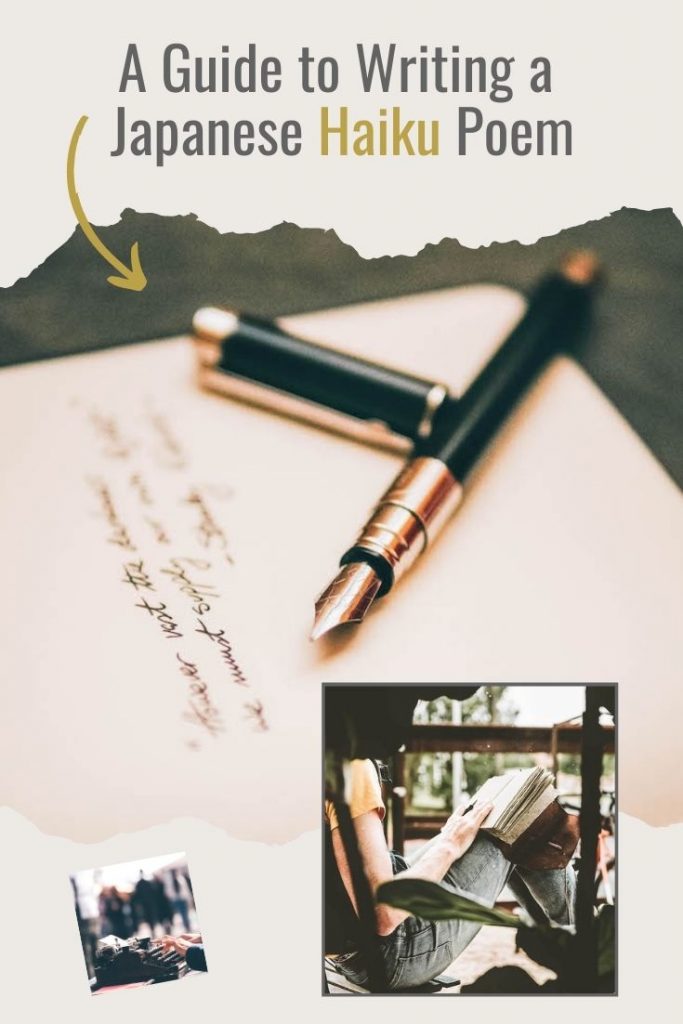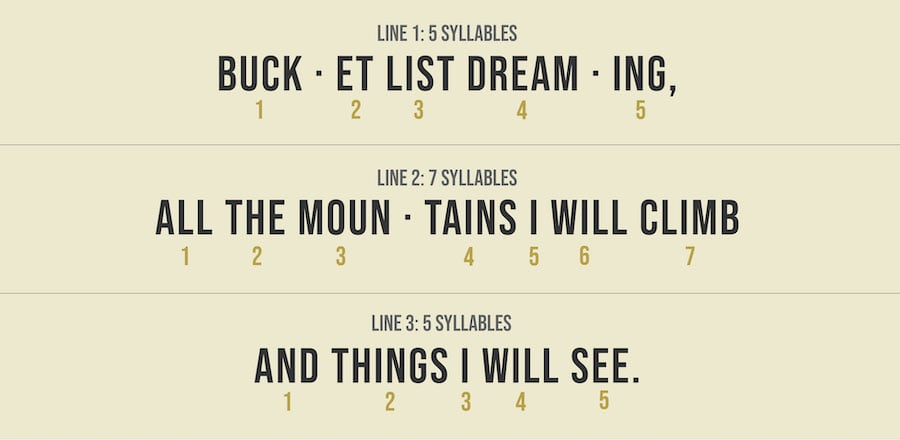When first adding write a haiku to my bucket list, I thought checking it off would be no problem at all. These super short Japanese poems take on a format of only seventeen syllables long, three lines and about a dozen measly words. How hard could it be? Well, even though it’s a fairly simple bucket list idea (and a fun thing to do without leaving the house), it’s not so easy peasy that you’ll be whipping out tons of them in one day! Sometimes writing a long story can be simpler than writing something short and meaningful.
How to write a haiku? These tips and examples will help…

How to Write a Japanese Haiku Poem: The Format with 15 Examples (including my own!)
What is a Haiku?
Haiku is a short versed Japanese poem that has just seventeen syllables, traditionally written in three lines:
- Line One has 5 syllables
- Line Two has 7 syllables
- Line Three has 5 syllables
It’s been a while since school…what is a syllable? A syllable is a single sound or beat in a word. For example, ad·ven·ture has three syllables and the word ex·pe·ri·ence has four.
Haiku originated as the opening part of a Japanese collaborative poem, called renga. After the first verse was written, it was passed to the next poet who added more lines to it. But over time the first verse, haiku, became a separate genre that spread throughout the world. Now you can find haiku poems in many different languages.
Traditionally, haiku poems are simplistic and describe images of the nature or seasons. But, nowadays they can be about anything you like. What’s even better is that you don’t have to worry about finding words that rhyme because the lines of a haiku rarely ever do!
Traditional Haiku Elements
If you’d like to write a more traditional Japanese haiku then here are some format and structure elements to be aware of:
- Kireji (“cutting word”): Cutting words technically have no meaning or definition, they act more like punctuation, except they are spoken words instead of symbols. You can think of a cutting word as comma, an indication to pause.
- Kigo: Kigo is a word (or phrase) that symbolizes one of the four seasons.
- Sensory Images: traditional haiku are about sensory images and not ideas. They use the five senses—sound, sight, taste, touch and smell.
You can read a lot more about traditional haiku disciplines here or here.

Tips on How to Write a Haiku
Now that you know the definition of a haiku, how do you write one and check this off your bucket list? Here’s some tips:
1. Observe nature silently. To get inspired go out, sit silently, and simply observe. Nature is full of life, action, and harmony. Soon your mind will calm and you will feel this harmony within yourself.
2. Embrace the moment—concentrate on here and now. The Japanese are experts on enjoying the moment. In fact, many of the haiku poets were Zen teachers, so they knew a thing or two about meditation and catching the beauty of the moment.
3. Remember the structure. Five-seven-five syllables. Line one should talk about one thing, line two about another, line three provides a connection between the two.
4. Don’t bother too much with grammar and punctuation. The punctuation and grammar are up to the author (lovely, right?) No rhyme needed either!
5. Use simple words. You don’t have to show off with elaborate and flowery language. Haiku captures the beauty of nature in simple yet strong words.
6. Picture the essence. Try describing what you see on the sheet of paper and then cross out all the words that do not picture the essence. What makes the picture you are observing now unique? What creates the strongest feeling? Subtract ruthlessly. Everything that isn’t “Hell, yes!” is a “No” It may be difficult at first, but with practice, you’ll hone your focus and intuition. By the way, a famous Russian writer, Anton Chekhov used to edit his drafts up to 40 times, to make them as general as possible, and to capture the essence of human interaction. Remember him, while working on you haiku.
7. Learn from the best. Read as many haiku as you can. Analyze the ones you really like, find the connections, and add them to your file. The more you read, the better your brain will recognize the patterns and connections, and the richer your images will become.


15 Haiku Examples
These are examples of haiku poems—some traditional and some modern. With the former of the two the 5-7-5 rhythm can get lost in translation, but you are still able to get inspired by their beauty.
TRADITIONAL
An old silent pond…
A frog jumps into the pond,
splash! Silence again.
—Matsuo Basho
the disk moon
the disk frozen lake
reflecting each other
—HASHIMOTO Takako
A fallen blossom
returning to the bough, I thought —
But no, a butterfly.
—Arakida Moritake, translation by Steven D. Carter
Now it reveals its hidden side
and now the other—thus it falls,
an autumn leaf.
—Ryōkan Taigu
in the autumn wind
standing alone
a shadow
—Ryōkan Taigu
People step in the air.
The water wheel
At the green paddy fields.
—Masaoka Shiki
the sky I see
seems full of
magnolia blossoms
—Natsume Soseki
The lamp once out
Cool stars enter
The window frame.
—Natsume Soseki
In nooks and corners
Cold remains:
Flowers of the plum
—Yosa Buson, translated by RH Blyth
bitter winter wind
ends there —
sound of the sea
—IKENISHI Gonsui
to tangle or untangle
the willow—
it’s up to the wind
—Fukuda Chiyo-ni
MODERN
Picking up pebbles
Or seashells strewn on soft sand
Pure relaxation.
—Paul Holmes
Full strawberry moon,
ushers in hot days of June,
high tides fill the dune
—Patricia L Cisco
Glorious sunset
Decorating the night sky…
Awaiting the moon
—David Fox
And last, but not least. This is the haiku I wrote on my birthday:
A plane flies over,
you dream of being on it.
Ideas flourish.
Want be inspired by more haiku poems? These 108 poems will cultivate awareness and open your heart.
Why should I write a haiku? You may ask. Haiku teaches us to notice the elegant beauty of each moment of life. If you make writing haiku a daily exercise, not only will the format come easy, but you will also be trained to see amazing things around you that usually go unnoticed. In the hassle of modern life, stop sometimes, observe the beauty that’s around you…
People rushing round,
Collected and observing
Writing a haiku.
This post may contain affiliate links. If you make a purchase through my links, I earn a commission that helps to keep this blog running—at no extra cost to you. For more information read my full disclosure.
More CREATIVE Bucket List Ideas
The 10 Best Adult Paint by Numbers Kits (+ Tips to Complete Them)
How (and Why) to Write a Letter to Your Future Self
Best 1000 Piece Jigsaw Puzzles for Adults (& Tips to Complete One)
10 Easy Harmonica Songs (& How to Play Them)


I am going to try this and add it to my post about forest bathing in Kyoto
the gentle sound of
a deer quiet as they are
it is just like me